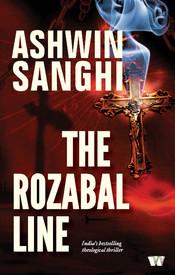 Ashwin Sanghi is no Dan Brown. Through and despite the anagrams, the sinister secret societies, the precious primitive parchments, the cryptic codes, the approaching Armageddon, the clueless clue-hunting central character and the done-to-death theological premise, one notes with regret (and also some amount of self-deprecating disgust) the willing suspension of disbelief in shady conspiracy theories that seem to be making authors with tremendous enterprise though little literary merit into trillionaires. The anagrams are childish (politeness prevents one from branding them foolish), the not-so-secret-after-Dan-Brown secret societies laughable; the valuable ancient parchments are sturdy enough to bear the brunt of regular “STD/ISD/FAX/XEROX”-type photocopying machines without crumbling to dust and the codes supposed to detonate the holocaust-inducing nuclear bomb can be decoded easily with the help of a mirror and some quick binary mathematics. Old Professor Moriarty would have hung his head in shame.
Ashwin Sanghi is no Dan Brown. Through and despite the anagrams, the sinister secret societies, the precious primitive parchments, the cryptic codes, the approaching Armageddon, the clueless clue-hunting central character and the done-to-death theological premise, one notes with regret (and also some amount of self-deprecating disgust) the willing suspension of disbelief in shady conspiracy theories that seem to be making authors with tremendous enterprise though little literary merit into trillionaires. The anagrams are childish (politeness prevents one from branding them foolish), the not-so-secret-after-Dan-Brown secret societies laughable; the valuable ancient parchments are sturdy enough to bear the brunt of regular “STD/ISD/FAX/XEROX”-type photocopying machines without crumbling to dust and the codes supposed to detonate the holocaust-inducing nuclear bomb can be decoded easily with the help of a mirror and some quick binary mathematics. Old Professor Moriarty would have hung his head in shame. Of course one would be mistaken to presume that this worthy tome has any aspirations to literary merit. It humbly proclaims to be merely “India’s bestselling theological thriller” on the semi-metaphorically designed book-cover. And one has to consider – it is no mean feat to attain bestselling-status when one has to slog away valuable man-hours typing in keywords into various internet search engines like Answers, Google, Wikipedia, AltaVista et al to collate data that is to be remixed and regurgitated in print bound within the covers of a bestseller. One cannot but admire the author for his imagination and innovation – it requires “razor-sharp intelligence” to be able to type in the exact keywords that would dredge up shady, obscure “Adventure Press Unlimited”-type online resources.
So now that we have the “bestselling” part sorted, let us attempt to dissect the “theological thriller” part. Same old, same old theological mystery: the greatest cover-up in the history of mankind. Jesus was a man, not God (or Son thereof); he was married, not celibate; his consort was Mary Magdalene, who in turn was the manifestation of the Sacred Feminine, and not a prostitute; they had children, daughters to be precise, who were hidden so well to protect the bloodline that the bloodline was all but lost from common consciousness. The Roman Catholic Church, of course, is the culprit behind the conspiracy, ensuring divine status for a human being by creating the myth of his death and miraculous resurrection while in reality, he survived to die at a ripe old age and was buried in Kashmir. The Rozabal Line is nothing but the strand of hair of the Rose – the hair is the line and the Rose, of course, is we already know who. Far-reaching? No. Far-fetched? Definitely. Even though one knows one is reading fiction (as prefaced in the Author’s Note), the verisimilitude to reality that is the hallmark of this genre is strangely lacking, so much so that the climactic hypothesis that should have felt like a wondrous and momentous revelation of the Truth instead feels like a lame dodo. Considering the author has already bagged a film-deal for another of his bestsellers, this book makes one feel as if one has wasted a multiplex evening (with all its associations and accoutrements) on a movie that could have easily been a straight-to-DVD release! Which brings us to the thriller part.
Perhaps the constant temporal and spatial shifts to mythical centuries and exotic places are intended to give the readers the simulation of thrill while enlightening them with the author’s diligent data-collation passing off as erudition, but all they succeed in giving are persistent migraines with the shoddy, juvenile language and flippantly irrelevant plot-meandering. Perhaps the entire point of the exercise IS to exhibit diligence and erudition, in which case one has to apologize for being juvenile enough to expect a coherent plot.
One small niggling doubt before we draw this review to a close. Which demographic was Mr.Sanghi directing his masterpiece at? The teens? The tweens? The pre-teens? The 25-35 young adult crowd? The 40-something born-agains? The typical racy thriller audience? Because simplistically stating matters of Karma and Rebirth in a sentence like- “Terry Acton had guillotined her in a previous birth as Sanson and so she chopped off his head in the present birth. Tit for tat!” – is bound to be scoffed at by ANY discerning reader, no matter what the age. Dan Brown for infants anyone? The preachy, pseudo-scholarly tone is hard to digest otherwise. Perhaps one is unfortunately too old and/or too discerning to be able to derive enjoyment from this masterpiece.
The beginning of the book is promising though it quickly loses its shine even before one is halfway through, with zero pace and zilch for character development. But the end convinces one of something – not everyone can be a Dan Brown, not everyone can be an Amish Tripathi, but everyone can hope to be published. Just some basic remixing of resources and you are on a roll. You just need to know where to click. In that respect Mr.Sanghi is truly a leading light.
Image taken from Google.
